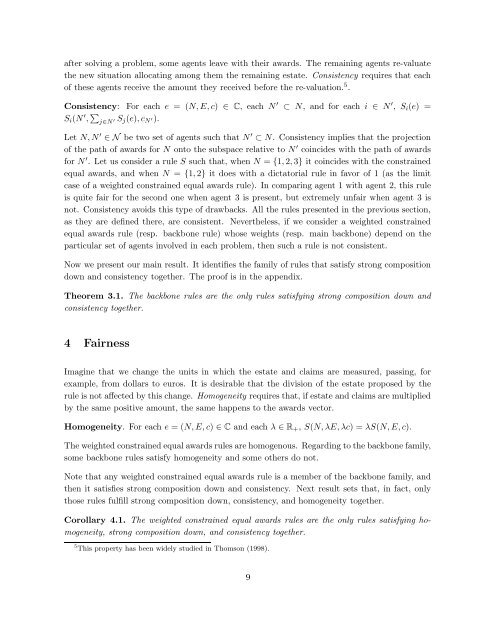STRONG COMPOSITION DOWN. CHARACTERIZATIONS OF ... - Ivie
Create successful ePaper yourself
Turn your PDF publications into a flip-book with our unique Google optimized e-Paper software.
after solving a problem, some agents leave with their awards. The remaining agents re-valuate<br />
the new situation allocating among them the remaining estate. Consistency requires that each<br />
of these agents receive the amount they received before the re-valuation. 5 .<br />
Consistency: For each e = (N,E,c) ∈ C, each N ′ ⊂ N, and for each i ∈ N ′ , S i (e) =<br />
S i (N ′ , ∑ j∈N ′ S j(e),c N ′).<br />
Let N,N ′ ∈ N be two set of agents such that N ′ ⊂ N. Consistency implies that the projection<br />
of the path of awards for N onto the subspace relative to N ′ coincides with the path of awards<br />
for N ′ . Let us consider a rule S such that, when N = {1,2,3} it coincides with the constrained<br />
equal awards, and when N = {1,2} it does with a dictatorial rule in favor of 1 (as the limit<br />
case of a weighted constrained equal awards rule). In comparing agent 1 with agent 2, this rule<br />
is quite fair for the second one when agent 3 is present, but extremely unfair when agent 3 is<br />
not. Consistency avoids this type of drawbacks. All the rules presented in the previous section,<br />
as they are defined there, are consistent. Nevertheless, if we consider a weighted constrained<br />
equal awards rule (resp. backbone rule) whose weights (resp. main backbone) depend on the<br />
particular set of agents involved in each problem, then such a rule is not consistent.<br />
Now we present our main result. It identifies the family of rules that satisfy strong composition<br />
down and consistency together. The proof is in the appendix.<br />
Theorem 3.1. The backbone rules are the only rules satisfying strong composition down and<br />
consistency together.<br />
4 Fairness<br />
Imagine that we change the units in which the estate and claims are measured, passing, for<br />
example, from dollars to euros. It is desirable that the division of the estate proposed by the<br />
rule is not affected by this change. Homogeneity requires that, if estate and claims are multiplied<br />
by the same positive amount, the same happens to the awards vector.<br />
Homogeneity. For each e = (N,E,c) ∈ C and each λ ∈ R + , S(N,λE,λc) = λS(N,E,c).<br />
The weighted constrained equal awards rules are homogenous. Regarding to the backbone family,<br />
some backbone rules satisfy homogeneity and some others do not.<br />
Note that any weighted constrained equal awards rule is a member of the backbone family, and<br />
then it satisfies strong composition down and consistency. Next result sets that, in fact, only<br />
those rules fulfill strong composition down, consistency, and homogeneity together.<br />
Corollary 4.1. The weighted constrained equal awards rules are the only rules satisfying homogeneity,<br />
strong composition down, and consistency together.<br />
5 This property has been widely studied in Thomson (1998).<br />
8

















